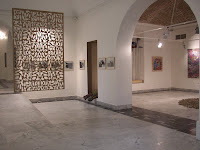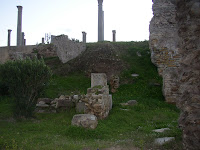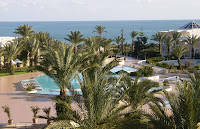As I was on holiday, I was determined not do studio visits. In any case i was never far away from culture directly or indirectly. As fate would have it one of the guest i had contact with happened to be connected to an art magazine in Paris. At this stage we were both only really interested in bargains at the souks with a bit of tourism thrown in. So off we went to Nabeul and old Hammamet in search of 'authentic' tunisian culture. The souks were a total disappointment full of manufactured 'artefacts' and fake designer bags. The tourist industry and industrialisation seems to have killed off the artisanat trades. But my friend did manage to pick up some very nice carpets at incredible bargain prices. After a watered down version of a couscous lunch we headed back to the sanctity of the hotel. The next day I was given a personalised tour of the retrospective exhibition of one of Tunisian's leading artist Abderrasak Sahli at the Musee de la Ville de Tunis. A good size space that had been beautifully restored.
Display of Abderrasak Sahli's exhibition in Tunis 


 My last day in Tunisia was to be spent in Tunis with friend and curator Rachida Triki Professor of Philosphy of Aesthetics of Art at the University. With her husband also professor of philosophy of History at the University of Tunis, I got a first class introductory course into the cultural history of Tunisia. This was splintered with ‘fieldwork’ to culture spaces such as 1 or 2 galleries, Carthage and the beautiful Sidi Bou Said. Tunisia is really beautiful country and it would not be an exaggeration to say that Tunis is almost a perfect city. Due to a flight mix-up up with my airline that decided to leave 7hrs early than scheduled without notifying me. I had another day to spend in the city. This was spent at the Souk where I got hooked in the jewellery section which had absolutely beautiful hand crafted silver jewellery with semi precious stones. The prices were unbelievable so i helped myself to quite a few.
My last day in Tunisia was to be spent in Tunis with friend and curator Rachida Triki Professor of Philosphy of Aesthetics of Art at the University. With her husband also professor of philosophy of History at the University of Tunis, I got a first class introductory course into the cultural history of Tunisia. This was splintered with ‘fieldwork’ to culture spaces such as 1 or 2 galleries, Carthage and the beautiful Sidi Bou Said. Tunisia is really beautiful country and it would not be an exaggeration to say that Tunis is almost a perfect city. Due to a flight mix-up up with my airline that decided to leave 7hrs early than scheduled without notifying me. I had another day to spend in the city. This was spent at the Souk where I got hooked in the jewellery section which had absolutely beautiful hand crafted silver jewellery with semi precious stones. The prices were unbelievable so i helped myself to quite a few.
I was fascinated with the intricate design of metal work that adorned the windows and doors of most houses. 
 Remaining Roman ruins at Carthage.
Remaining Roman ruins at Carthage. 
 Souk shopping
Souk shopping
 Tea time in a beautiful cafe in Sidi Bou Said. Tunis is a very beautiful city and extremely developed. It is the most European of African cities. Its infrastructure is first class and would leave alot of western cities gasping and some of the societal statistics are staggering. Over 80% literacy, 100% accommodation with 85% owner-occupier, self-sufficiency in food, and good manufacturing base which means basic necessities are made in the country hence affordable to the populace. The city is clinically clean and after 2 days the perfectness of the city began to give it an air of artificiality.
Tea time in a beautiful cafe in Sidi Bou Said. Tunis is a very beautiful city and extremely developed. It is the most European of African cities. Its infrastructure is first class and would leave alot of western cities gasping and some of the societal statistics are staggering. Over 80% literacy, 100% accommodation with 85% owner-occupier, self-sufficiency in food, and good manufacturing base which means basic necessities are made in the country hence affordable to the populace. The city is clinically clean and after 2 days the perfectness of the city began to give it an air of artificiality.The visual art scene is relatively small in Tunisia, with the older generation of modernist painters holding tightly to their dominant positions. Rachida commented on the lack of a collective art community resulting in individual isolated activity. There are few art galleries, and very minimal committed public support. The younger generation of artists have yet to devise a strategy that breaks not only the generational stranglehold but also stymies creative degradation. It goes without saying that the contact between Tunisia and sub saharah african is almost non-existent. That is changing especially now that the headquarters of the African Development Bank - formely in Ivory Coast - has relocated to the Tunis. There is a small but growing population of West African professional elites now living in Tunisia. This has inevitably led to more contact and has resulted in arousing the curosity of the Tunisians about their fellow Africans who they know nothing about. Mobility between North and West Africa is still difficult, inconvenient and expensive but that should change over the next 12 months. Increased movementled to reduction in price and mobility of ideas, trade and people will increase considerable. This pressages an important future for intra Africa exchange and development and artists and other cultural workers will form an important part of this mobility.
 Myriam works in a varied of format such as sculptural installations, video but primarily in photography and explores issue of cultural metissage, dispacement, rupture, nodamism, history and memory amongst others. The professional observations and interest will continue from afar in the hope that one day soon - our schedules permitting - we will have time to really talk. From the little I saw of the beauty of Casablanca it now features high on my list of countries to visit sooner than later. After Tunisia and Morocco I realise that my knowledge of the history, culture and politics of the northern countries of Africa remains superficial at best.
Myriam works in a varied of format such as sculptural installations, video but primarily in photography and explores issue of cultural metissage, dispacement, rupture, nodamism, history and memory amongst others. The professional observations and interest will continue from afar in the hope that one day soon - our schedules permitting - we will have time to really talk. From the little I saw of the beauty of Casablanca it now features high on my list of countries to visit sooner than later. After Tunisia and Morocco I realise that my knowledge of the history, culture and politics of the northern countries of Africa remains superficial at best.







